A Survey of Knowledge Graph Approaches and Applications in Education
Abstract
1. Introduction
- What are the patterns of publications on knowledge graphs in education?
- What are the educational contexts of knowledge graph applications?
- What are the objectives, application categories, data sources, technical means, and pedagogical issues for knowledge graph approaches and applications in education?
2. Related Work
3. Methodology
3.1. Data Collection
3.2. Data Analysis
4. Results
4.1. Overview of the Publications
4.1.1. Year of Publication
4.1.2. Country/Region of Authors’ Affiliations
4.1.3. Research Methods
4.2. Contexts of Knowledge Graph Approaches
4.2.1. Level of Education
4.2.2. Subject Disciplines
4.3. Implementation of Knowledge Graph Approaches
4.3.1. Types of Objectives
4.3.2. Types of Application Categories
4.3.3. Types of Knowledge Graph Resources
4.3.4. Types of Technical Means
4.3.5. Types of Pedagogies
5. Discussion
6. Conclusions
Author Contributions
Funding
Conflicts of Interest
References
- Kejriwal, M. Knowledge graphs: A practical review of the research landscape. Information 2022, 13, 161. [Google Scholar] [CrossRef]
- Hogan, A.; Blomqvist, E.; Cochez, M.; d’Amato, C.; Melo, G.D.; Gutierrez, C.; Kirrane, S.; Gayo, J.E.L.; Navigli, R.; Neumaier, S.; et al. Knowledge graphs. ACM Comput. Surv. 2021, 54, 71. [Google Scholar]
- Ji, S.; Pan, S.; Cambria, E.; Marttinen, P.; Philip, S.Y. A survey on knowledge graphs: Representation, acquisition, and applications. IEEE Trans. Neural Netw. Learn. Syst. 2021, 33, 494–514. [Google Scholar] [CrossRef]
- Tiddi, I.; Lécué, F.; Hitzler, P. (Eds.) Knowledge Graphs for Explainable Artificial Intelligence: Foundations, Applications and Challenges; IOS Press: Amsterdam, The Netherlands, 2020. [Google Scholar]
- Singhal, A. Introducing the Knowledge Graph: Things, Not Strings. Official Google Blog. 2012. Available online: https://blog.google/products/search/introducing-knowledge-graph-things-not/ (accessed on 25 May 2024).
- Tiwari, S.; Al-Aswadi, F.N.; Gaurav, D. Recent trends in knowledge graphs: Theory and practice. Soft Comput. 2021, 25, 8337–8355. [Google Scholar] [CrossRef]
- Wu, T.; Qi, G.; Li, C.; Wang, M. A survey of techniques for constructing Chinese knowledge graphs and their applications. Sustainability 2018, 10, 3245. [Google Scholar] [CrossRef]
- Troussas, C.; Krouska, A.; Tselenti, P.; Kardaras, D.K.; Barbounaki, S. Enhancing personalized educational content recommendation through cosine similarity-based knowledge graphs and contextual signals. Information 2023, 14, 505. [Google Scholar] [CrossRef]
- Albreiki, B.; Habuza, T.; Palakkal, N.; Zaki, N. Clustering-based knowledge graphs and entity-relation representation improves the detection of at risk students. Educ. Inf. Technol. 2023, 29, 6791–6820. [Google Scholar] [CrossRef]
- Chung, C.Y.; Hsiao, I.H.; Lin, Y.L. AI-assisted programming question generation: Constructing semantic networks of programming knowledge by local knowledge graph and abstract syntax tree. J. Res. Technol. Educ. 2023, 55, 94–110. [Google Scholar] [CrossRef]
- Limongelli, C.; Lombardi, M.; Marani, A.; Taibi, D. A semantic approach to ranking techniques: Improving web page searches for educational purposes. IEEE Access 2022, 10, 68885–68896. [Google Scholar] [CrossRef]
- Shang, S.; Lyv, W.; Luo, L. Applying lean six sigma incorporated with big data analysis to curriculum system improvement in higher education institutions. Int. J. Syst. Assur. Eng. Manag. 2022, 13, 641–656. [Google Scholar]
- Zablith, F. Constructing social media links to formal learning: A knowledge graph approach. Educ. Technol. Res. Dev. 2022, 70, 559–584. [Google Scholar] [CrossRef]
- Mzwri, K.; Turcsányi-Szabo, M. Internet wizard for enhancing open-domain question-answering chatbot knowledge base in education. Appl. Sci. 2023, 13, 8114. [Google Scholar] [CrossRef]
- Choi, H.; Lee, H.; Lee, M. Optimal knowledge component extracting model for knowledge-concept graph completion in education. IEEE Access 2023, 11, 15002–15013. [Google Scholar] [CrossRef]
- Yuan, R.; Li, H.; Sun, Z.; Zhang, H. Application of graph convolutional network in the construction of knowledge graph for higher mathematics teaching. Sens. Mater. 2023, 35, 4269–4290. [Google Scholar] [CrossRef]
- Xiao, X.; Fang, Z.; Zou, S.; Zhang, C.; Chen, X. Effects of an intelligent cues recognition-based multilevel knowledge graphs generation method on students in online learning environments. Interact. Learn. Environ. 2023. [Google Scholar] [CrossRef]
- Abu-Salih, B.; Alotaibi, S. A systematic literature review of knowledge graph construction and application in education. Heliyon 2024, 10, e25383. [Google Scholar] [CrossRef] [PubMed]
- Elkaimbillah, Z.; Rhanoui, M.; Mikram, M.; El Asri, B. Comparative study of knowledge graph models in education domain. In Proceedings of the International Conference on Bigdata, Modelling and Machine Learning, Cox’s Bazar, Bangladesh, 23–25 September 2021. [Google Scholar]
- Fettach, Y.; Ghogho, M.; Benatallah, B. Knowledge graphs in education and employability: A survey on applications and techniques. IEEE Access 2022, 10, 80174–80183. [Google Scholar] [CrossRef]
- Chen, X.; Xie, H.; Li, Z.; Cheng, G. Topic analysis and development in knowledge graph research: A bibliometric review on three decades. Neurocomputing 2021, 461, 497–515. [Google Scholar] [CrossRef]
- Wang, G.; He, J. A bibliometric analysis of recent developments and trends in knowledge graph research (2013–2022). IEEE Access 2024, 12, 32005–32013. [Google Scholar] [CrossRef]
- Wang, Q.; Mao, Z.; Wang, B.; Guo, L. Knowledge graph embedding: A survey of approaches and applications. IEEE Trans. Knowl. Data Eng. 2017, 29, 2724–2743. [Google Scholar] [CrossRef]
- Rajabi, E.; Etminani, K. Knowledge-graph-based explainable AI: A systematic review. J. Inf. Sci. 2022. [Google Scholar] [CrossRef]
- Tian, L.; Zhou, X.; Wu, Y.P.; Zhou, W.T.; Zhang, J.H.; Zhang, T.S. Knowledge graph and knowledge reasoning: A systematic review. J. Electron. Sci. Technol. 2022, 20, 100159. [Google Scholar] [CrossRef]
- Abu-Salih, B. Domain-specific knowledge graphs: A survey. J. Netw. Comput. Appl. 2021, 185, 103076. [Google Scholar] [CrossRef]
- Chiu, B.; See-To, W.K.E.; Ngai, E.W.T. Knowledge graph construction and applications in e-retailing: A review of literature. In Proceedings of the Pacific Asian Conference on Information Systems, Virtual, 12 July 2021; p. 244. [Google Scholar]
- Wang, S.; Lin, M.; Ghosal, T.; Ding, Y.; Peng, Y. Knowledge graph applications in medical imaging analysis: A scoping review. Health Data Sci. 2022, 2022, 9841548. [Google Scholar] [CrossRef] [PubMed]
- Abu-Salih, B.; Al-Qurishi, M.; Alweshah, M.; AL-Smadi, M. Healthcare knowledge graph construction: State-of-the-art, open issues, and opportunities. arXiv 2022, arXiv:2207.03771. [Google Scholar]
- Li, K.C.; Wong, B.T.M. Review of smart learning: Patterns and trends in research and practice. Australas. J. Educ. Technol. 2021, 37, 189–204. [Google Scholar] [CrossRef]
- Jardim, J.; Bártolo, A.; Pinho, A. Towards a global entrepreneurial culture: A systematic review of the effectiveness of entrepreneurship education programs. Educ. Sci. 2021, 11, 398. [Google Scholar] [CrossRef]
- Alonso, R.K.; Vélez, A.; Martínez-Monteagudo, M.C.; Rico-González, M. Flipped learning in higher education for the development of intrinsic motivation: A systematic review. Educ. Sci. 2023, 13, 1226. [Google Scholar] [CrossRef]
- Paneque, M.; del Mar Roldán-García, M.; García-Nieto, J. e-LION: Data integration semantic model to enhance predictive analytics in e-Learning. Expert Syst. Appl. 2023, 213, 118892. [Google Scholar] [CrossRef]
- Zheng, L.; Kinshuk; Fan, Y.; Long, M. The impacts of the comprehensive learning analytics approach on learning performance in online collaborative learning. Educ. Inf. Technol. 2023, 28, 16863–16886. [Google Scholar] [CrossRef]
- Zheng, L.; Niu, J.; Long, M.; Fan, Y. An automatic knowledge graph construction approach to promoting collaborative knowledge building, group performance, social interaction and socially shared regulation in CSCL. Br. J. Educ. Technol. 2023, 54, 686–711. [Google Scholar] [CrossRef]
- Zheng, L.; Long, M.; Chen, B.; Fan, Y. Promoting knowledge elaboration, socially shared regulation, and group performance in collaborative learning: An automated assessment and feedback approach based on knowledge graphs. Int. J. Educ. Technol. High. Educ. 2023, 20, 46. [Google Scholar] [CrossRef]
- Han, D.; Kim, D.; Kim, M.; Han, K.; Yi, M.Y. Temporal enhanced inductive graph knowledge tracing. Appl. Intell. 2023, 53, 29282–29299. [Google Scholar] [CrossRef]
- Troussas, C.; Krouska, A. Path-based recommender system for learning activities using knowledge graphs. Information 2023, 14, 9. [Google Scholar] [CrossRef]
- Yang, Y.; Chen, S.; Zhu, Y.; Zhu, H.; Chen, Z. Knowledge graph empowerment from knowledge learning to graduation requirements achievement. PLoS ONE 2023, 18, e0292903. [Google Scholar] [CrossRef] [PubMed]
- Ain, Q.U.; Chatti, M.A.; Bakar, K.G.C.; Joarder, S.; Alatrash, R. Automatic Construction of Educational Knowledge Graphs: A Word Embedding-Based Approach. Information 2023, 14, 526. [Google Scholar] [CrossRef]
- Sin, Z.P.; Jia, Y.; Wu, A.C.; Zhao, I.D.; Li, R.C.; Ng, P.H.; Baciu, G.; Cao, J.; Li, Q. Towards an edu-metaverse of knowledge: Immersive exploration of university courses. IEEE Trans. Learn. Technol. 2023, 16, 1096–1110. [Google Scholar] [CrossRef]
- Hu, Y.; Xu, B. Analysis of the dilemma of higher vocational thinking education in China under the background of “Internet+”. Appl. Math. Nonlinear Sci. 2024, 9, 1–15. [Google Scholar] [CrossRef]
- Zhang, W.; Chung Ee, J.Y. An Intelligent Knowledge Graph-Based Directional Data Clustering and Feature Selection for Improved Education. Int. J. Recent Innov. Trends Comput. Commun. 2023, 11, 22–33. [Google Scholar] [CrossRef]
- Liu, C.; Zhang, J.; Zhang, H.; Li, X.; Zhang, E. Group Cooperative Teaching Design with Knowledge Graphs in Project-Driven Learning. Int. J. Inf. Commun. Technol. Educ. 2023, 19, 1–11. [Google Scholar] [CrossRef]
- Nguyen, H.D.; Truong, D.; Vu, S.; Nguyen, D.; Nguyen, H.; Tran, N.T. Knowledge management for information querying system in education via the combination of rela-ops model and knowledge graph. J. Cases Inf. Technol. 2023, 25, 1–17. [Google Scholar] [CrossRef]
- Nguyen, H.D.; Huynh, H.; Mai, T. Design an Ontology-based model for Intelligent Querying system in Mathematics Education. J. Interdiscip. Math. 2023, 26, 449–473. [Google Scholar] [CrossRef]
- Coccoli, M.; Torre, I.; Galluccio, I. User experience evaluation of Edurell interface for video augmentation. Multimed. Tools Appl. 2024, 83, 36695–36717. [Google Scholar] [CrossRef]
- Liu, J.Y.; Wang, F.; Ma, H.P.; Huang, Z.Y.; Liu, Q.; Chen, E.H.; Su, Y. A Probabilistic Framework for Temporal Cognitive Diagnosis in Online Learning Systems. J. Comput. Sci. Technol. 2023, 38, 1203–1222. [Google Scholar] [CrossRef]
- Agrawal, G.; Deng, Y.; Park, J.; Liu, H.; Chen, Y.C. Building knowledge graphs from unstructured texts: Applications and impact analyses in cybersecurity education. Information 2022, 13, 526. [Google Scholar] [CrossRef]
- Weichselbraun, A.; Waldvogel, R.; Fraefel, A.; van Schie, A.; Kuntschik, P. Building Knowledge Graphs and Recommender Systems for Suggesting Reskilling and Upskilling Options from the Web. Information 2022, 13, 510. [Google Scholar] [CrossRef]
- Li, N.; Shen, Q.; Song, R.; Chi, Y.; Xu, H. MEduKG: A deep-learning-based approach for multi-modal educational knowledge graph construction. Information 2022, 13, 91. [Google Scholar] [CrossRef]
- Keshan, N.; Fontaine, K.; Hendler, J.A. Semiautomated process for generating knowledge graphs for marginalized community doctoral-recipients. Int. J. Web Inf. Syst. 2022, 18, 413–431. [Google Scholar] [CrossRef]
- Yang, S.; Cai, X. Bilateral knowledge graph enhanced online course recommendation. Inf. Syst. 2022, 107, 102000. [Google Scholar] [CrossRef]
- Ezaldeen, H.; Bisoy, S.K.; Misra, R.; Alatrash, R. Semantics-aware context-based learner modelling using normalized PSO for personalized E-learning. J. Web Eng. 2022, 21, 1187–1224. [Google Scholar] [CrossRef]
- Wu, Z.; Jia, F. Construction and Application of a Major-Specific Knowledge Graph Based on Big Data in Education. Int. J. Emerg. Technol. Learn. 2022, 17, 64–79. [Google Scholar] [CrossRef]
- Zhong, M.; Ding, R. Design of a personalized recommendation system for learning resources based on collaborative filtering. Int. J. Circuits Syst. Signal Process. 2022, 16, 122–131. [Google Scholar] [CrossRef]
- Nafa, F.; Babour, A.; Melton, A. Prerequisite relations among knowledge units: A case study of computer science domain. Comput. Model. Eng. Sci. 2022, 133, 639–652. [Google Scholar] [CrossRef]
- Hou, Q. Design of a Visual Training System for Software Engineering Education Based on Knowledge Graphs. Int. J. Emerg. Technol. Learn. 2022, 17, 114–130. [Google Scholar] [CrossRef]
- Liu, P.; Cao, Y.; Wang, L. A Multimodal Fusion Online Music Education System for Universities. Comput. Intell. Neurosci. 2022, 2022, 6529110. [Google Scholar] [CrossRef]
- Badawy, A.; Fisteus, J.A.; Mahmoud, T.M.; Abd El-Hafeez, T. Topic extraction and interactive knowledge graphs for learning resources. Sustainability 2021, 14, 226. [Google Scholar] [CrossRef]
- Martin, A.J.; Dominic, M.M. Personalization of learning objects according to the skill set of the learner using knowledge graph. Turk. J. Comput. Math. Educ. 2021, 12, 3974–3987. [Google Scholar]
- Yang, Z.; Wang, Y.; Gan, J.; Li, H.; Lei, N. Design and research of intelligent question-answering (Q&A) system based on high school course knowledge graph. Mob. Netw. Appl. 2021, 26, 1884–1890. [Google Scholar]
- Hur, Y.; Jo, J. Development of Intelligent Information System for Digital Cultural Contents. Mathematics 2021, 9, 238. [Google Scholar] [CrossRef]
- Lv, P.; Wang, X.; Xu, J.; Wang, J. Intelligent personalised exercise recommendation: A weighted knowledge graph-based approach. Comput. Appl. Eng. Educ. 2021, 29, 1403–1419. [Google Scholar] [CrossRef]
- Xu, G.; Jia, G.; Shi, L.; Zhang, Z. Personalized course recommendation system fusing with knowledge graph and collaborative filtering. Comput. Intell. Neurosci. 2021, 2021, 9590502. [Google Scholar] [CrossRef]
- Zhang, Z. A method of recommending physical education network course resources based on collaborative filtering technology. Sci. Program. 2021, 2021, 9531111. [Google Scholar] [CrossRef]
- Cui, J.; Yu, S. Fostering deeper learning in a flipped classroom: Effects of knowledge graphs versus concept maps. Br. J. Educ. Technol. 2019, 50, 2308–2328. [Google Scholar] [CrossRef]
- Telnov, V.; Korovin, Y. Semantic web and knowledge graphs as an educational technology of personnel training for nuclear power engineering. Nucl. Energy Technol. 2019, 5, 273–280. [Google Scholar] [CrossRef]
- Chi, Y.; Qin, Y.; Song, R.; Xu, H. Knowledge graph in smart education: A case study of entrepreneurship scientific publication management. Sustainability 2018, 10, 995. [Google Scholar] [CrossRef]
- Chen, P.; Lu, Y.; Zheng, V.W.; Chen, X.; Yang, B. Knowedu: A system to construct knowledge graph for education. IEEE Access 2018, 6, 31553–31563. [Google Scholar] [CrossRef]
- Shen, T.; Nagai, Y.; Zhao, J.; Shen, T. Hotspots and trends in knowledge graph and concept generation based on bibliometric analysis. In Proceedings of the 2020 International Conference on Intelligent Design (ICID), Xi’an, China, 11–13 December 2020; IEEE: Piscataway, NJ, USA, 2020; pp. 124–127. [Google Scholar]
- State Council. New Generation of Artificial Intelligence Development Plan. 2017. Available online: https://flia.org/wp-content/uploads/2017/07/A-New-Generation-of-Artificial-Intelligence-Development-Plan-1.pdf (accessed on 25 May 2024).
- Grad-Gyenge, L.; Kiss, A.; Filzmoser, P. Graph embedding based recommendation techniques on the knowledge graph. In Proceedings of the Adjunct Publication of the 25th Conference on User Modeling, Adaptation and Personalization, Bratislava, Slovakia, 9–12 July 2017; pp. 354–359. [Google Scholar]

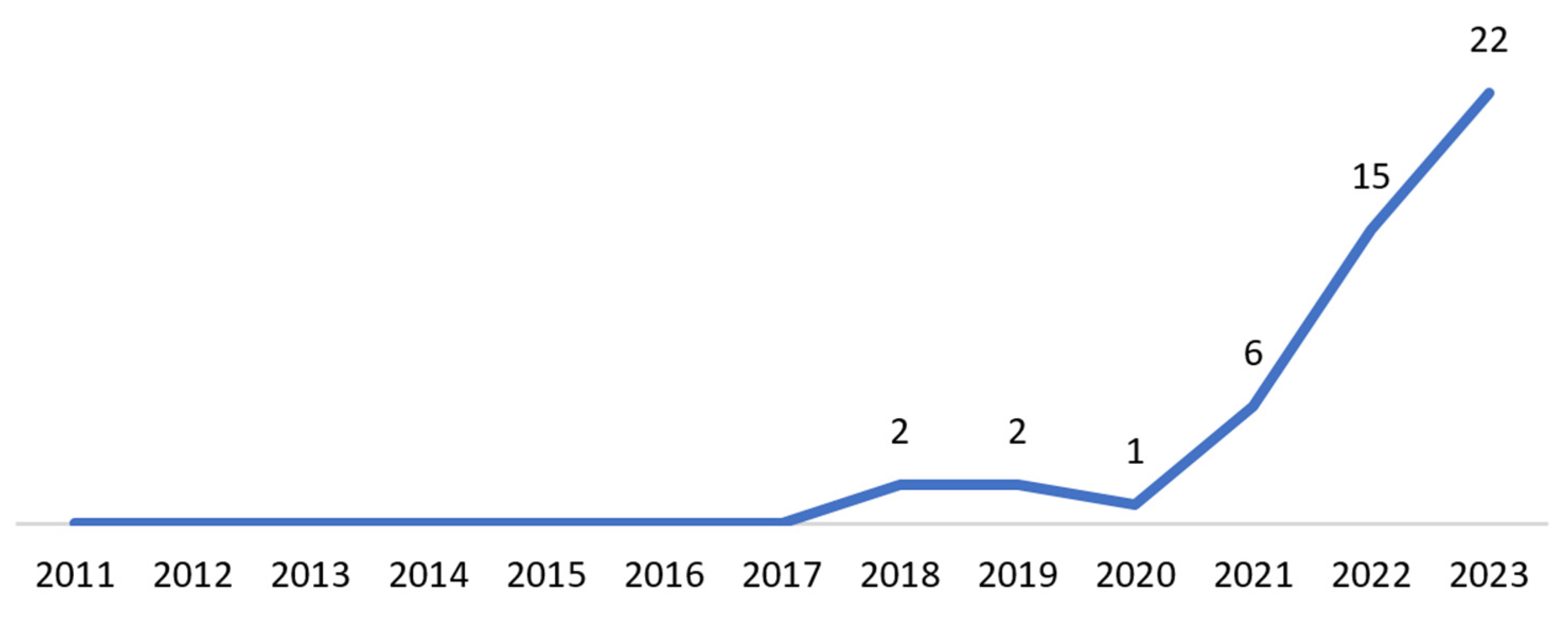
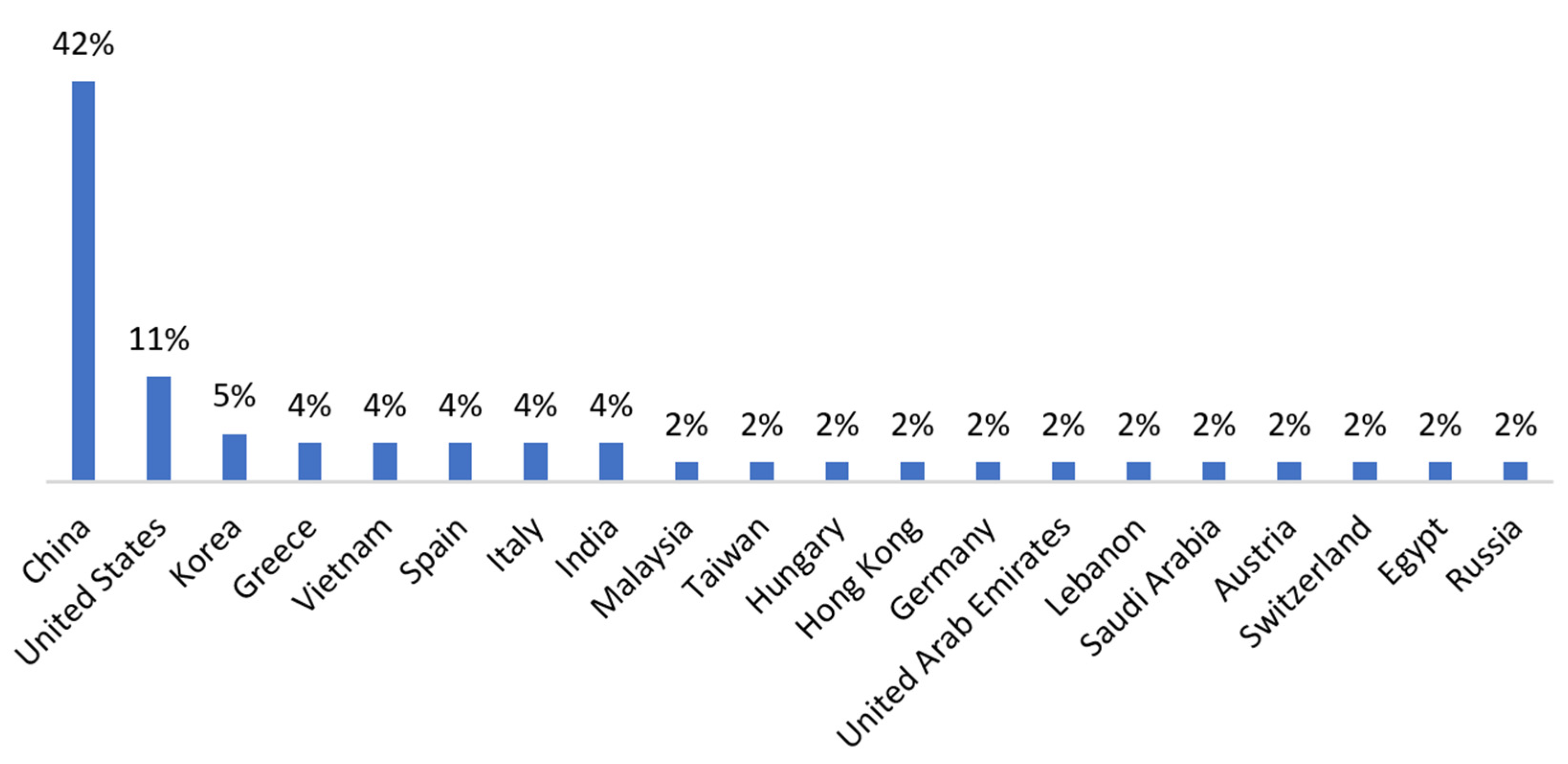
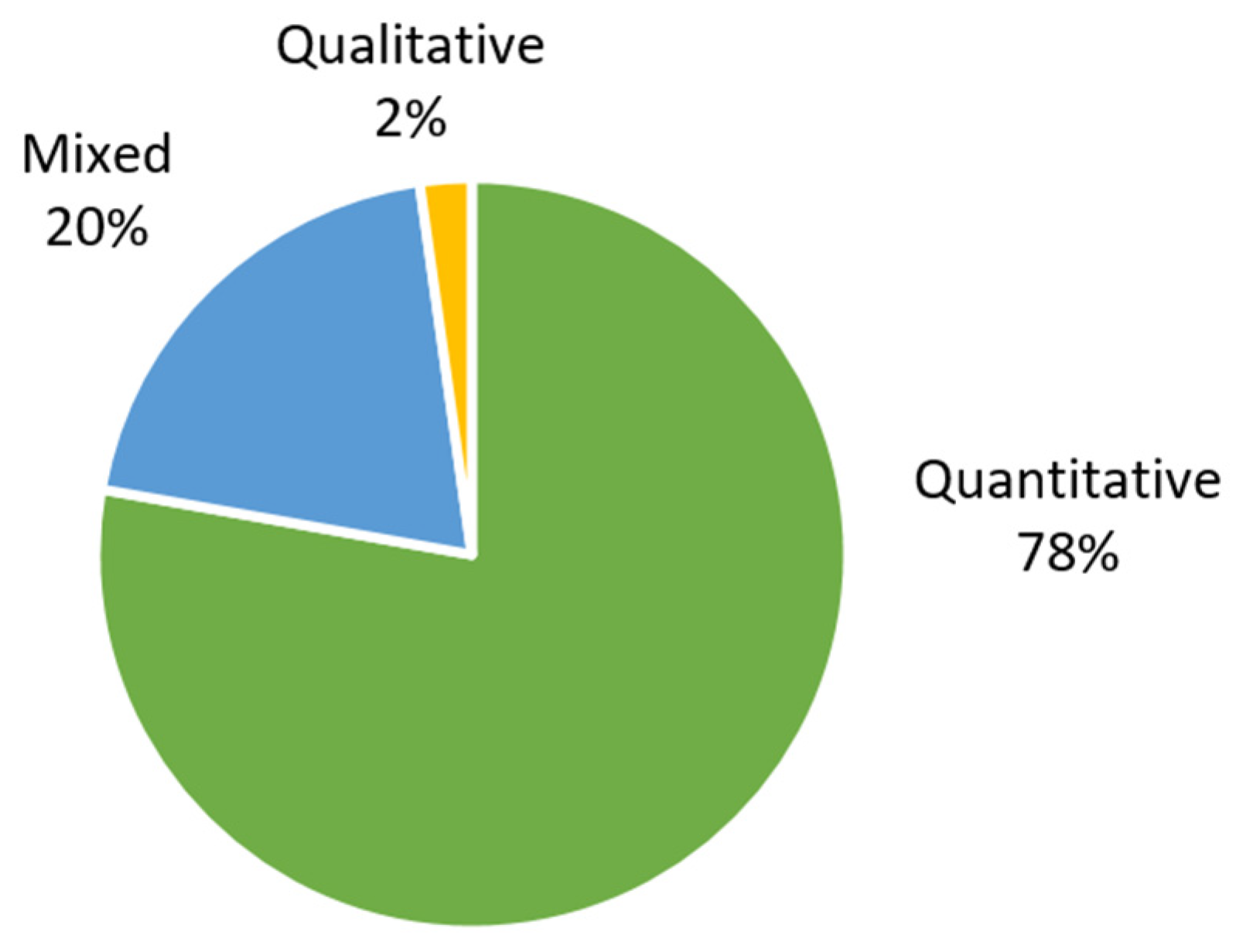

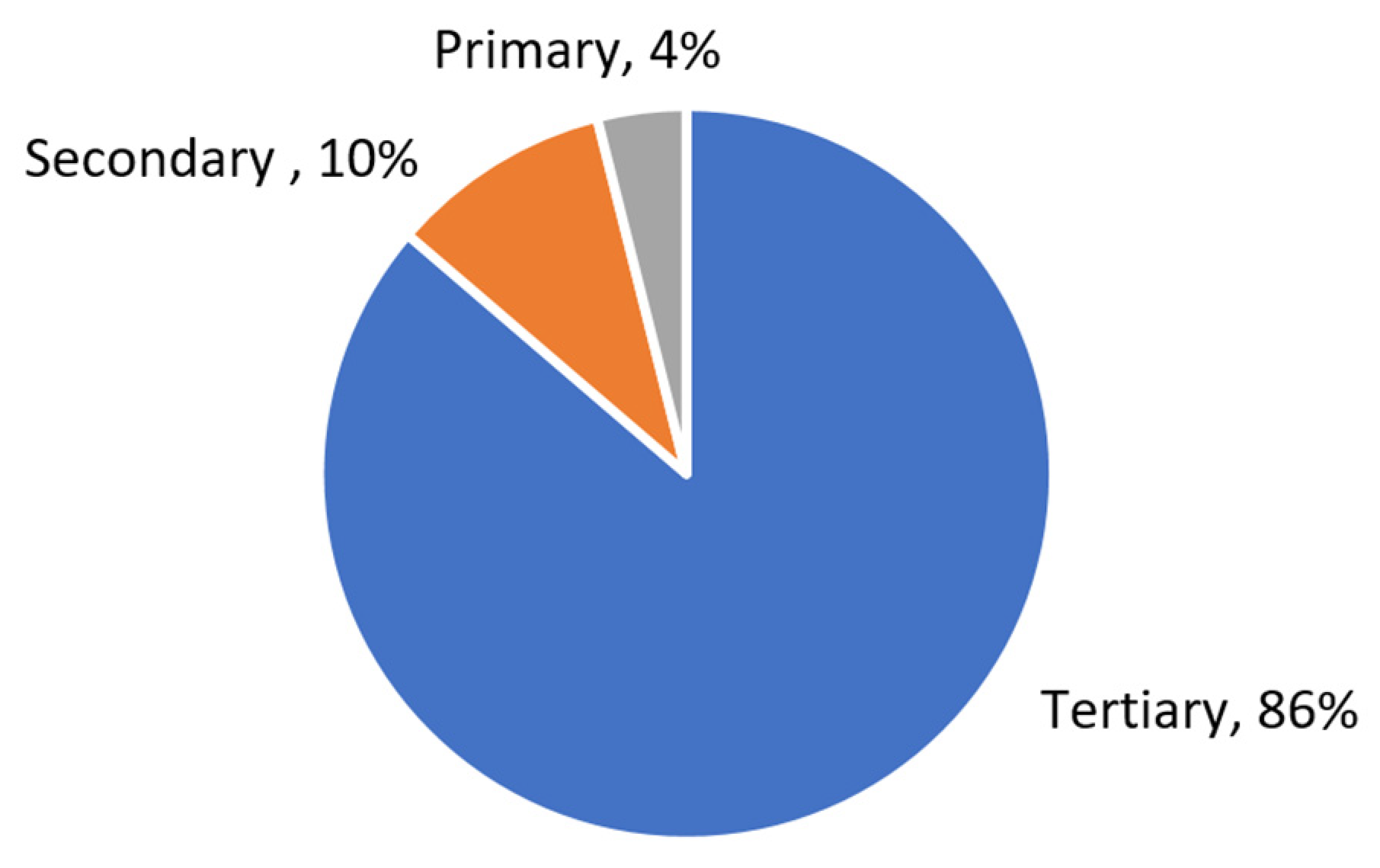
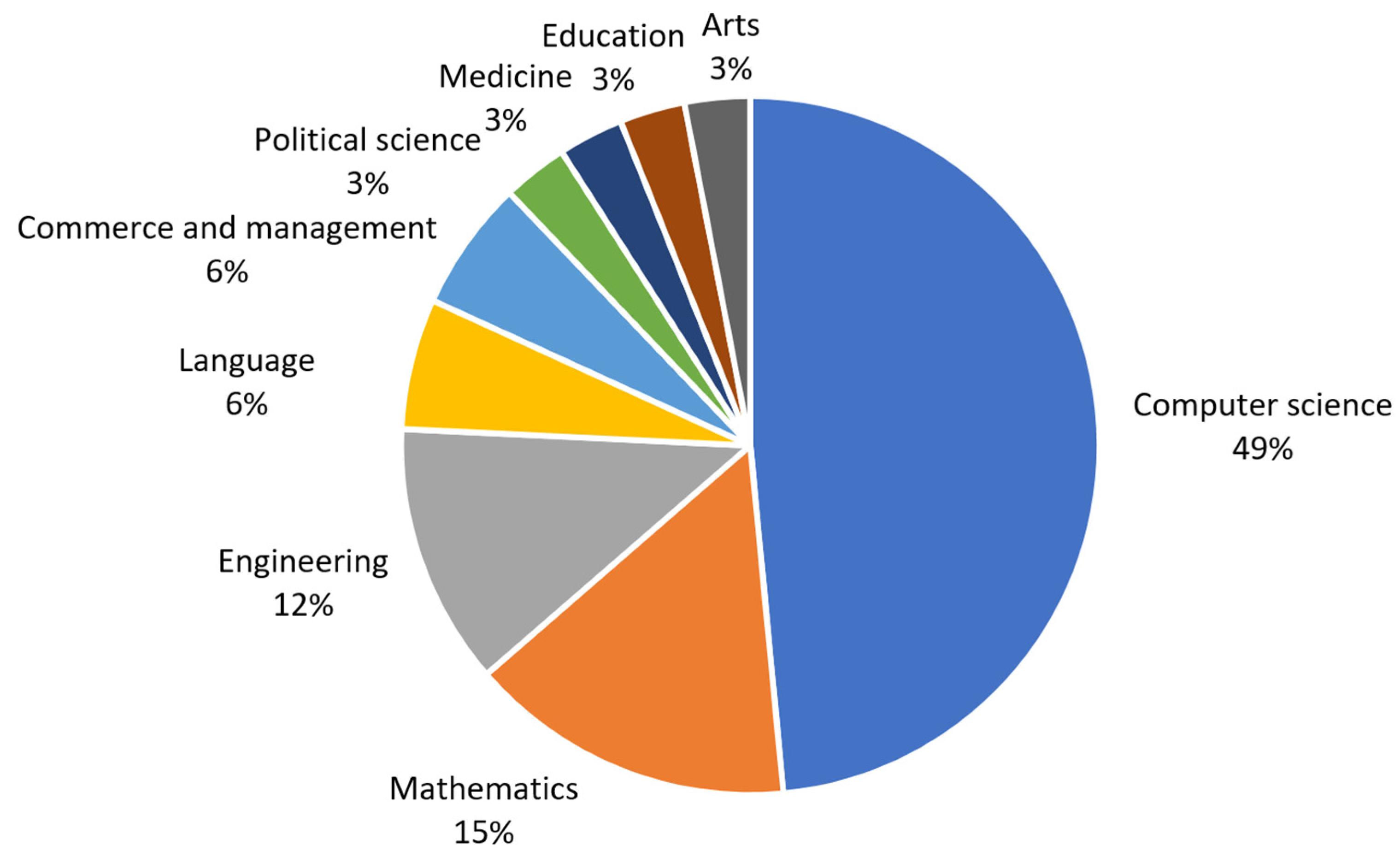
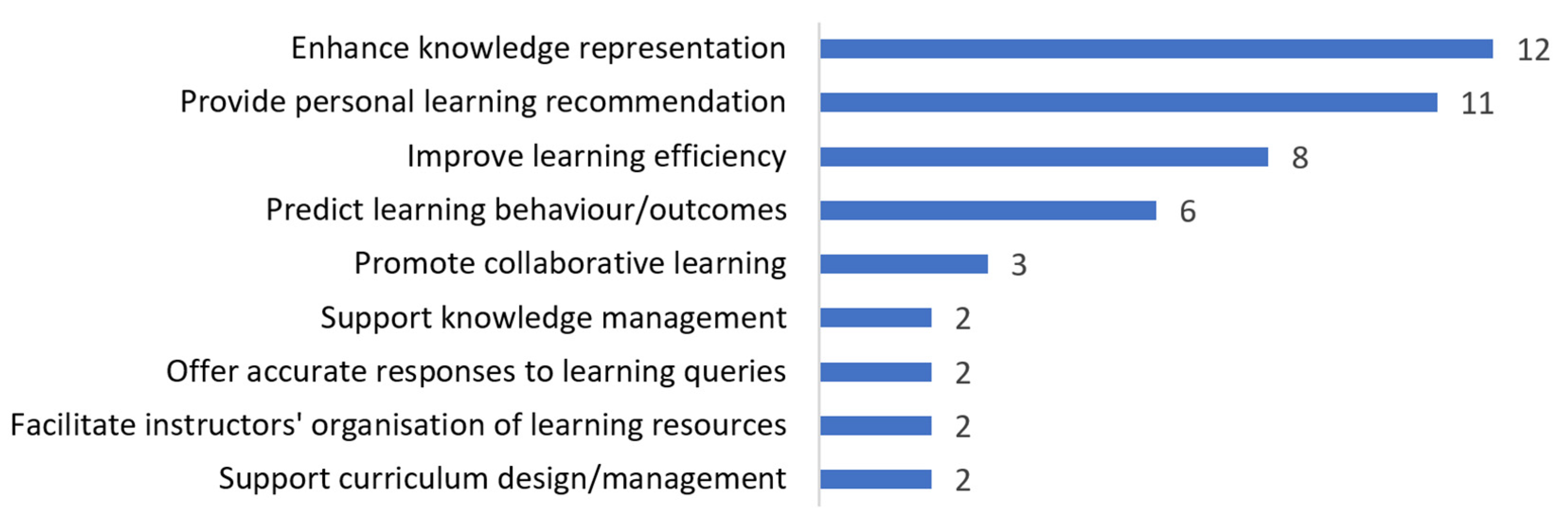


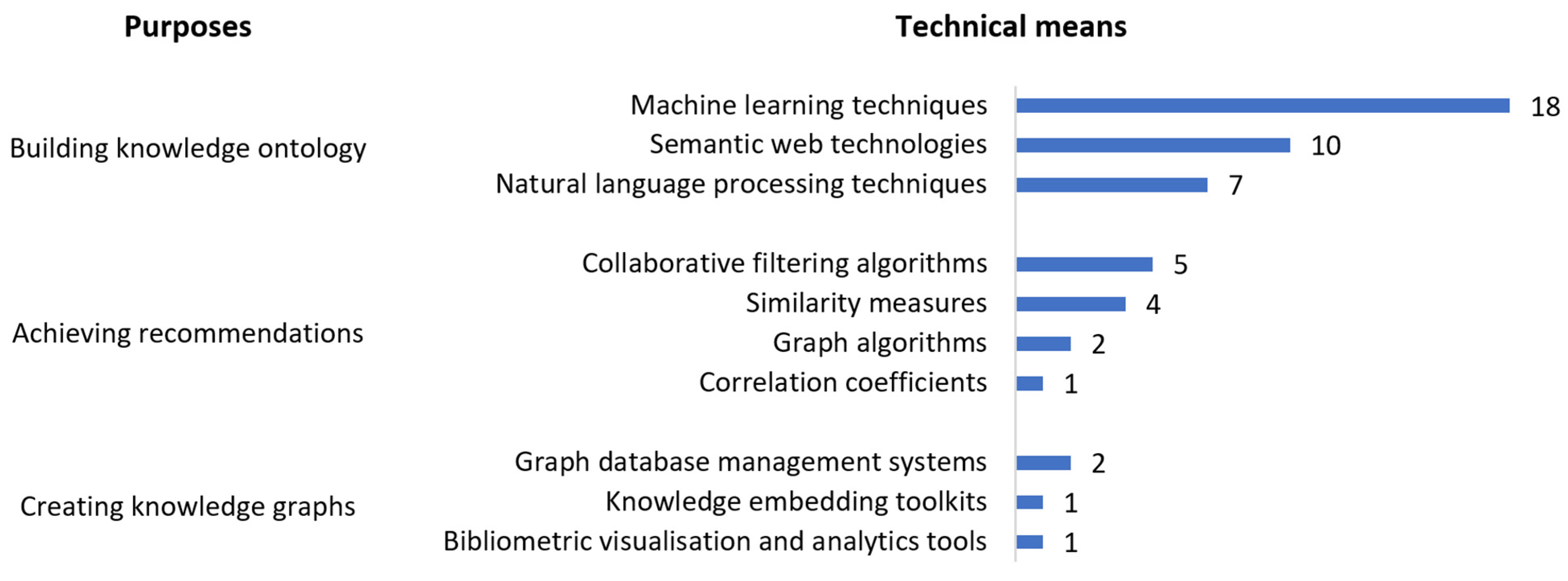

| Ref. | Objectives | Application Categories | Knowledge Graph Resources | Technical Means | Pedagogies | Limitations |
|---|---|---|---|---|---|---|
| [8] | Enhance personalised educational content recommendation. | Educational recommendation | Learning resources, learner attributes, and preferences | Cosine similarity | Personalised learning |
|
| [10] | Facilitate question generation for instructors. | Question generation | Textbooks | Semantic networks | N/A |
|
| [15] | Find a meaningful knowledge-concept path. | Concept instruction | Student log data | Feature selection using Elastic Net (LASSO) + RF algorithm | Personalised learning |
|
| [14] | Empower a question-answering Chabot to respond to queries. | Question answering | Wikipedia | The Wit.ai NLP model | N/A |
|
| [33] | Enable semantic querying, predictive modelling, and reasoning for student behaviour analysis. | Prediction of educational outcomes | LMSs (Moodle, COCO Udemy, Open University) | OWL 2 ontology | N/A |
|
| [34] | Support collaborative knowledge building. | Educational recommendations and educational assessment and feedback | Online discussion transcripts | BERT-BiLSTM-CRF | Collaborative learning |
|
| [35] | Improve collaborative learning performance. | Educational recommendations and educational assessment and feedback | Online discussion transcripts | BERT-BiLSTM-CRF and BERT-Random Forest | Collaborative learning |
|
| [36] | Promote knowledge elaboration. | Educational assessment and feedback | Online discussion transcripts | BERT-BiLSTM-CRF | Collaborative learning |
|
| [37] | Predict students’ mastery of knowledge based on their learning activity. | Prediction of educational outcomes | English problem-solving record data from EdNet and ASSIST2017 | Graph neural network | Personalised learning |
|
| [38] | Improve the recommendation of learning activities. | Educational recommendations | Textbooks, student learning activities | Similarity measures | Personalised learning |
|
| [39] | Help students find out courses and knowledge related to graduation requirements. | Learning resources searching | Syllabi, teachers’ lesson plans, and webpages | Ontology construction, Large Language Models | Personalised learning |
|
| [40] | Offer learners a semantic representation of domain concepts. | Concept instruction | Learning materials, Wikipedia, and Dbpedia | SqueezeBERT, word and sentence embeddings | Personalised learning |
|
| [41] | Visualise the knowledge construction process. | Concept instruction | Lecture slides, Wikipedia, and videos | N/A | Immersive learning, collaborative learning |
|
| [9] | Identify students at risk of failing a course. | Prediction of educational outcomes | Course information, student historical features and performance | Ontology mapping | N/A |
|
| [16] | Help learners efficiently memorise and learn concepts. | Concept instruction | Textbooks, Baidupedia, and students’ classroom responses (collected using sensors) | Graph convolutional network (GCN), BiLSTM-CRF | Personalised learning |
|
| [42] | Support knowledge sharing and learning in groups. | Concept instruction | DBpedia, Wikidata, and YAGO3 | Embedding-based knowledge map fusion algorithm | Collaborative learning |
|
| [43] | Predict and analyse student educational outcomes. | Prediction of educational outcomes | The Linked Data for Education dataset (learning resources), the Open Academic Graph dataset, DBpedia, and MOOC platforms | Feature selection using LSTM_GOA algorithm | N/A |
|
| [44] | Show the logic between knowledge. | Concept instruction | Individually constructed knowledge graphs by teachers and students | Knowledge fusion | Project-based learning, collaborative learning |
|
| [45] | Assist students in reviewing lectures and comprehending course material. | Learning resources searching | Textbooks | Ontology Rela-Ops model | N/A |
|
| [46] | Represent relations of knowledge components and retrieve contents of queries. | Learning resources searching | Textbooks and workbooks | Ontology Rela-Ops model | N/A |
|
| [47] | Enables learners to perform non-linear navigation of learning contents. | Concept instruction | Video lectures | Speech-to-text techniques and semantic analysis | N/A |
|
| [17] | Help students quickly and systematically grasp the framework and key content of video lectures. | Concept instruction | Video lectures | BERT, name entity recognition, and YOLOv3 | N/A |
|
| [48] | Estimate students’ proficiency in knowledge concepts. | Prediction of educational outcomes | Online tutoring system and E-learning platform | Recurrent neural network | N/A |
|
| [12] | Improve the curriculum system in higher education institutions. | Curriculum design and management | Course syllabi in the current university and the benchmarking top universities, teacher information | Latent Dirichlet Allocation | N/A |
|
| [13] | Construct meaningful connections between social media and formal learning. | Curriculum design and management | Course information, social media (Facebook, Twitter) | Semantic mediawiki | Collaborative learning |
|
| [49] | Provide concept visualisation and promote cognitive engagement. | Concept instruction | Course materials | Named-entity recognition and NLP | Problem-based learning |
|
| [50] | Provide semantic search for reskilling and upskilling options. | Educational recommendations | Education providers’ Webpages | Resource Description Framework, slot filling | N/A |
|
| [51] | Manage and present various modes of educational resources. | Knowledge management | Online education resources (e.g., Baidu entries), offline education resources (e.g., PowerPoints and class audios) | BERT-BiLSTM-CRF | N/A |
|
| [11] | Minimise the time instructors have to spend looking for teaching material. | Educational recommendations | DBpedia Knowledge Graphs, instructor’s teaching plans | Semantic similarity | N/A |
|
| [52] | Provide a comprehensive resource for students. | Learning resources searching | National Science Foundation, Survey of Earned Doctorates Restricted Data Analysis System, and Wikidata | Semantic Extract Transform and Load-er | N/A |
|
| [53] | Enhance online course recommendations to address user characteristics. | Educational recommendations | Two public datasets (Movielens-20M, Book-Crossing) and an industrial dataset | Graph convolutional network, Collaborative filtering algorithms | Personalised learning |
|
| [54] | Predict appropriate resources with the highest ranking linked to the learner’s interests. | Educational recommendations | E-content (e.g., E-Library, Coursera), user selections out of these materials | NLP | Personalised learning |
|
| [55] | Help students build complex knowledge structures. | Concept instruction | Educational resources, learning behaviour | Node feature extraction method | N/A |
|
| [56] | Help students access learning resources accurately and efficiently. | Educational recommendations | Learning behaviours, course information | Collaborative filtering algorithms, similarity measures | Personalised learning |
|
| [57] | Present knowledge units in a semantically well-organised manner. | Concept instruction | Textbooks | NLP | N/A |
|
| [58] | Communicate knowledge logically and coherently. | Concept instruction | N/A | Entity extraction, relation extraction, and attribute extraction | N/A |
|
| [59] | Improve the course recommendation accuracy for music education | Educational recommendations | Audio, sheet music, chants, and metadata | Resource Description Framework | Personalised learning |
|
| [60] | Enable students to seek out and examine educational resources that align with their interests. | Learning resources searching | Textbooks | Wikipedia Miner, NLP | Networked learning |
|
| [61] | Provide personalised learning content according to the skill set of learners. | Educational recommendations | Learning assessment, course materials | Named-entity recognition | Personalised learning |
|
| [62] | Predict students’ learning behaviour in order to provide feedback on the teaching effect. | Question answering | Subject materials and syllabi | Conditional Random Fields, TF-IDF | Problem-based learning, cognitive learning |
|
| [63] | Effectively provide information in response to searches for content that is useful to learners. | Learning resources searching | Webpages | Bi-LSTM model | N/A |
|
| [64] | Recommend personalised exercises to students in an appropriate order. | Educational recommendations | Textbook, Wikipedia, and testing behaviour of students | Collaborative filtering | Personalised learning |
|
| [65] | Provide personalised content for learners. | Educational recommendations | N/A | Collaborative filtering | Personalised learning |
|
| [66] | Effectively recommend learning resources to learners. | Educational recommendations | Webpages | Collaborative filtering | Personalised learning |
|
| [67] | Support students in constructing and expanding their knowledge structure. | Concept instruction | Student-generated knowledge graphs | N/A | Collaborative learning |
|
| [68] | Provide a well-structured overview of knowledge in nuclear power engineering. | Concept instruction | DBpedia | Semantic Similarity Measure, Resource Description Framework | N/A |
|
| [69] | Enhance scientific retrieval efficiency. | Knowledge management | Three scientific databases: Web of Science, Engineering Village, and EBSCO | Machine-learning algorithms | Problem-based learning |
|
| [70] | Support personalised teaching services and adaptive learning solutions. | Concept instruction | Standard curriculum data and learning assessment data | Gated recurrent unit network, probabilistic association rule mining algorithm | Personalised learning |
|
Disclaimer/Publisher’s Note: The statements, opinions and data contained in all publications are solely those of the individual author(s) and contributor(s) and not of MDPI and/or the editor(s). MDPI and/or the editor(s) disclaim responsibility for any injury to people or property resulting from any ideas, methods, instructions or products referred to in the content. |
© 2024 by the authors. Licensee MDPI, Basel, Switzerland. This article is an open access article distributed under the terms and conditions of the Creative Commons Attribution (CC BY) license (https://creativecommons.org/licenses/by/4.0/).
Share and Cite
Qu, K.; Li, K.C.; Wong, B.T.M.; Wu, M.M.F.; Liu, M. A Survey of Knowledge Graph Approaches and Applications in Education. Electronics 2024, 13, 2537. https://doi.org/10.3390/electronics13132537
Qu K, Li KC, Wong BTM, Wu MMF, Liu M. A Survey of Knowledge Graph Approaches and Applications in Education. Electronics. 2024; 13(13):2537. https://doi.org/10.3390/electronics13132537
Chicago/Turabian StyleQu, Kechen, Kam Cheong Li, Billy T. M. Wong, Manfred M. F. Wu, and Mengjin Liu. 2024. "A Survey of Knowledge Graph Approaches and Applications in Education" Electronics 13, no. 13: 2537. https://doi.org/10.3390/electronics13132537
APA StyleQu, K., Li, K. C., Wong, B. T. M., Wu, M. M. F., & Liu, M. (2024). A Survey of Knowledge Graph Approaches and Applications in Education. Electronics, 13(13), 2537. https://doi.org/10.3390/electronics13132537








